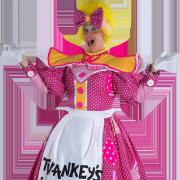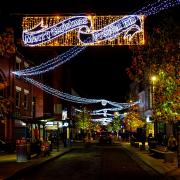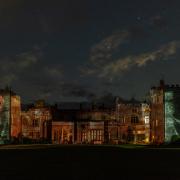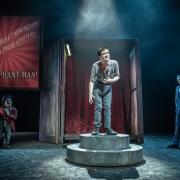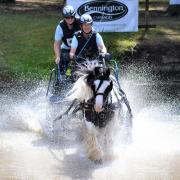A special exhibition commemorates the role of the 20th Hussars during the opening months of the First World War in Preston this July. The regiment saw some of the first and fiercest action of the conflict.

The Hussars’ War
The 20th Hussars played a hugely important role in the opening months of the First World War. Having taken part in the first action of the conflict, the experiences of this historic regiment give unique insight into what life was really like at the front.

Now local photographs, stories and artefacts bring these experiences to life, at a new exhibition opening at the Museum of the King’s Royal Hussars, situated in the Museum of Lancashire, Preston.
Created in partnership with the National Army Museum (NAM), Outbreak: Road to the Trenches forms part of the NAM’s extensive First World War commemoration programme. Drawing on recruitment and propaganda posters, uniforms, photographs, weapons and letters, engaging displays tell a World War story with personal and local elements to the 20th Hussars.
Central to the free exhibition is how the function of the regiment altered during the War, as it evolved to meet the changing nature of the conflict. Traditionally a cavalry regiment, soldiers in the 20th Hussars were skilled in horsemanship and fighting on open terrain. As the focus of the fighting evolved however into a new, static war fought in the trenches, these skills were in less demand. Images and artefacts together bring to life the regiment’s unique journey to be retrained early on in the conflict to fight as much-needed infantry instead.
A Not-So Royal Regiment
Nicknamed ‘Nobody’s Own’, the 20th Hussars was unusual in that, unlike most other regiments, it never had a royal colonel or colonel-in-chief. Formed in 1858 in India, the regiment had a reputation as a prestigious cavalry force when war broke out 1914.
The new exhibition explores how the 20th Hussars was one of the first regiments to be called up for action in 1914. It formed a vital part of the British Expeditionary Force (BEF), the name given to the first wave of troops sent to the Western Front after war was declared.
It then follows the regiment’s journey as it left from Southampton on the morning of 18th August 1914, arriving at Le Harve at 6pm later that day. The men and horses were then packed onto a train and sent towards the Belgian border.
First Days at the Front
Clear and colourful displays in the exhibition feature anecdotes from the soldiers who formed part of this early force. They include for example the difficulties faced by the regiment in getting the men and horses to shore – indeed one horse escaped and swam off into the harbour and had to be retrieved.
Outbreak: Road to the Trenches then follows the 20th Hussars all the way to the Belgian border, where by the 22nd August the regiment, along with the rest of the BEF, was in position at Mons. It was here that one of the most interesting artefacts to feature in the exhibition took centre stage.
As soon as they had arrived at Mons, ‘C’ Squadron, 20th Kings Hussars, were sent on patrol to scout out enemy positions, led by Lieutenant Goodhart. It turned out to be a patrol packed with incident, as the squadron soon ran into enemy cavalrymen.
Despite an order from Goodhart to dismount and hold fire, legend tells us that the excitement of the moment got to one of his men, who fired at the enemy. These could have been some of the first British shots of the First World War.
The mission continued and soon encountered German lancers. Goodhart made to fire his revolver at a charging lancer only to find he had forgotten to load it, leaving him with just his cavalry sword to defend himself. Luckily he was riding a trained polo pony that was very fast and nimble, enabling him to escape.
Goodhart survived the rest of the War, going on to receive the Military Cross. His unique cavalry sword is one of the key artefacts to feature in the Outbreak: Road to the Trenches exhibition, giving visitors the chance to envisage the brave lieutenant’s actions for themselves.
Hussars in Retreat
The Battle of Mons (23rd August 1914) was set to become one of the conflict’s most infamous confrontations, and it exposed the 20th Hussars to fierce fighting against a force over twice its size.
Despite the skill, bravery and determination of its soldiers the small British force was overwhelmed by the large German numbers, and soon the BEF was in retreat. The exhibition tells how the 20th Hussars continued to give cover to the retreating British infantry, becoming engaged in constant skirmishes with the advancing German forces.
British troops were driven as far back as the River Marne; situated dangerously close to Paris it was vital that they held this position to avoid what would have been a devastating strategic win for the Germans. The resulting First Battle of the Marne (5th – 12th September 1914) provided yet another challenge for the cavalry of the 20th Hussars, who had to dismount and walk across temporary pontoon bridges under heavy enemy fire.
Following the Battle of the Marne, the British and German forces reached a point where neither could advance. The order to entrench soon followed, signalling a change from open to static war – a new experience for the 20th Hussars who were used to fast-paced, open and mobile confrontation.
The Changing Face of War
It is here that the Outbreak: Road to the Trenches exhibition delves into how the 20th Hussars adapted to this new type of warfare. Their skills in horsemanship and conflict on open terrain were less in demand. Instead the 20th Hussars entered a new stage in their history as the men were retrained to fight as much-needed infantry in the trenches.
Before being taken for formal training however, the 20th Hussars would be forced to experience the hardships of early trench warfare. The exhibition reveals how the regiment had to resort to digging with a broken plate and cutlery, until a few spades could be borrowed from locals. The regiment’s entrenching tools had been lost at the Battle of the Marne; a mistake they could not afford to make again.
Football, Tug-of-War and Bayonets
Photographs in the exhibition follow the regiment as it was withdrawn from the front line on 22nd November 1914, to begin infantry training. Bringing to life their day-to-day regime the displays explore how the men took part in bayonet fighting - a reflection of their changing role – and played football and tug-of-war to keep fit.
Panels also look at how, on 2nd December, this training schedule was relaxed as King George V inspected them on his tour of the front.
With a focus on the early months of the war, the Museum of the King’s Royal Hussars’ new exhibition finishes at Christmas 1914, which the regiment spent in winter quarters completing their infantry training, adapting to their new role and reorganising. They returned to the front line on 3rd February 1915.
The exhibition is a fascinating way for local families to mark the War’s centenary, in a county that provided one of the primary recruitment locations for the regiment during the conflict.
Road to the Trenches takes place from 5th July 2014 – 17th November 2014 at the Museum of the King’s Royal Hussars. Stanley Street, Preston, Lancashire, PR1 4YP.
Admission is free.
About the National Army Museum
The National Army Museum explores the impact of the British Army on the story of Britain, Europe and the world; how Britain’s past has helped to shape our present and our future and how the actions of a few can affect the futures of many.
The National Army Museum was established by Royal Charter to tell the story of the Land Forces of the Crown wherever they were raised. Opened by the Queen in 1960, it moved to its current site in Chelsea in 1970.
About the Museum of the King’s Royal Hussars
Located together with the Duke of Lancaster’s Own Yeomanry Museum, within the Museum of Lancashire, the King’s Royal Hussars display tells the story of the 14th and 20th Hussars from the formation of the 14th in 1715. Preston is vitally important to that story, for the museum stands on the field of the regiment’s first battle, against the Jacobites.
Doors are open 10.30 am to 5 pm Tuesday to Saturday, and 12 to 5pm Sunday












